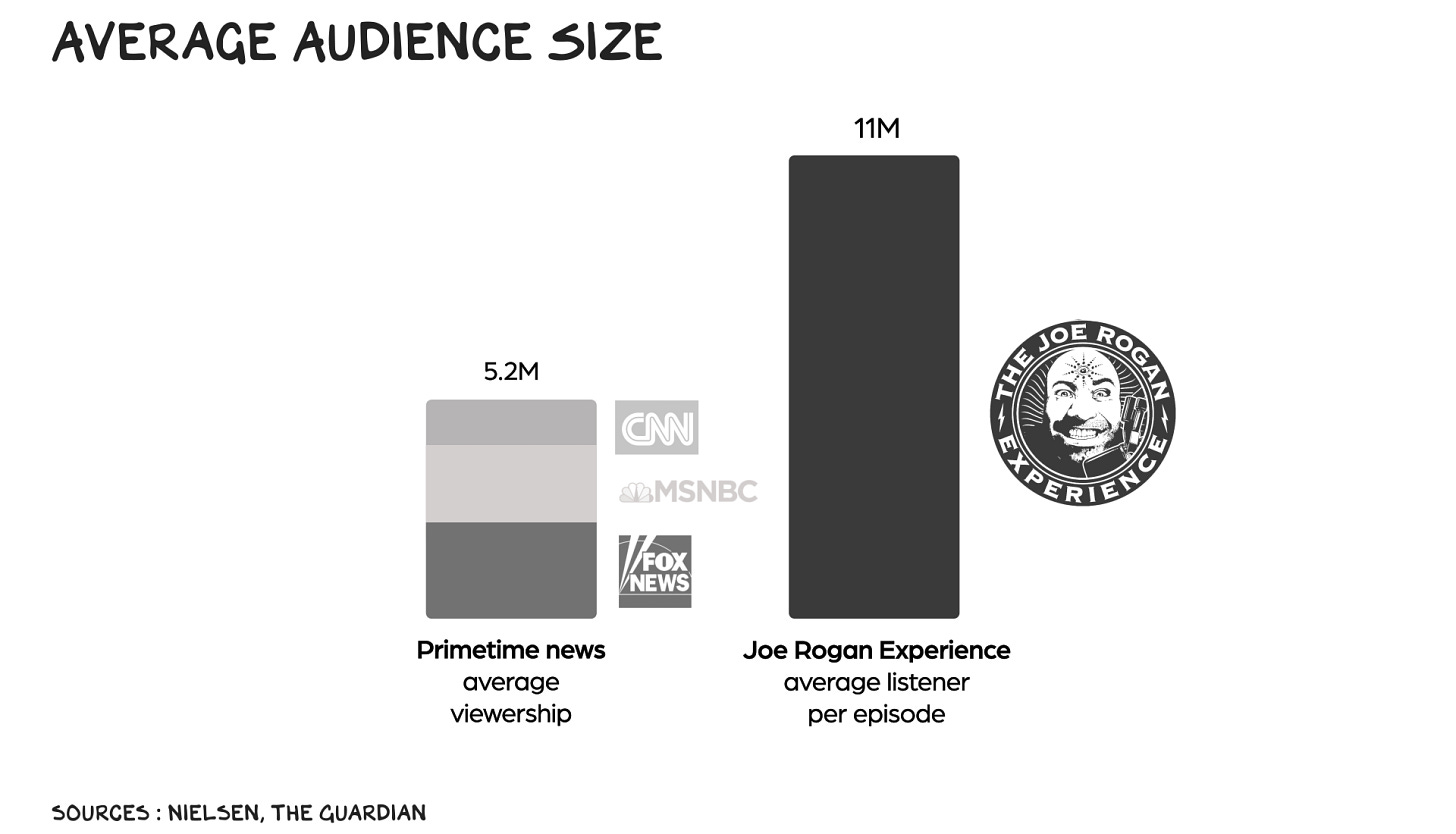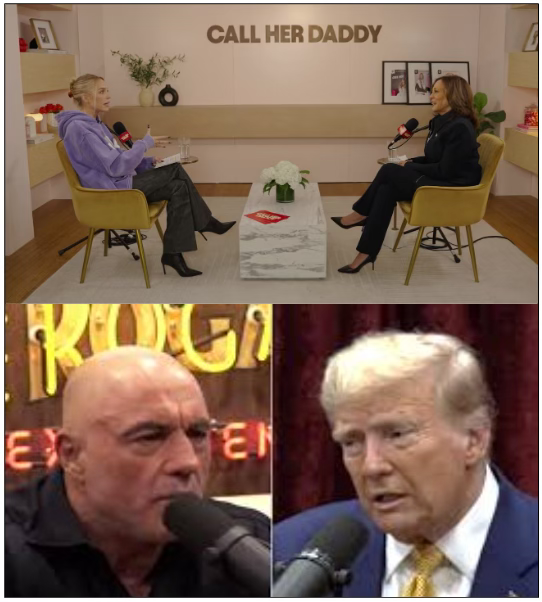The Podcast Election and Next Generation Media Infrastructure
The election catapulted the creator economy into the national spotlight, but can it thrive without reimagining how it works?
We have just survived what is already being dubbed The Podcast Election, and whether or not the manosphere actually activated millions of new voters, this election undoubtedly marked a moment when the perception of influence shifted from mainstream media to creators. Not many people are arguing the efficacy of display ads right now.
But beneath our analysis of Joe Rogan’s electoral power are fundamental challenges the creator-media economy will have to deal with, questions about where value is created, how the ecosystem is organized, and the downsides of moving from corporate media to individual creators.
Let’s start with an interesting discussion in Scott Galloway’s analysis, which is really a breakdown of the economics of podcasting. Despite the bad jokes (or because of them), Galloway claims that his podcasting mini-empire does $10 million in annual revenue with a team of eight, plus talent.
Media brands that do a million in revenue per employee are basically unicorns, and Galloway acknowledges that his level of success is only slightly more common than unicorn sightings.
Because of this ultra-streamlined operation, nearly all of the power flows directly from him.
Galloway asserts that: “In broadcast and cable TV, the platform has always been bigger than the talent. In podcasting, it’s the other way around. There is little sustainable enterprise value in a podcast company; what matters isn’t capex or infrastructure, it’s talent.”
He’s right. No one on his team could conceivably take over his role and there is no larger structure around him.
The Prof G Show is Scott Galloway. Same with Joe Rogan, Alex Cooper, Howard Stern and so on.

Social media and podcast platforms eliminated the biggest barrier to entry that corporate media brands once controlled — access to distribution. Remove the distribution monopoly from media, and zero capital media brand becomes possible. And once mirco-media is possible, the market will ruthlessly punish other models. Hence, podcast deals worth tens of millions going to relatively small producers.
Corporate media simply can’t compete with this uber-efficiency — tiny or no staff; centered around a single, powerful personality; creating deep connection and rapid-fire content with essentially no budget.
A second much-discussed trend runs parallel to this: the “intimacy” of podcast and social media currently favors lower production value, or at least the illusion of it. Consider that in just a few years, we’ve moved from media brands “pivoting to video” by building professional in-house studios, to videos with a floating head using TikTok and Instagram green screen tools. Guess which costs less and also drives more engagement in 2024?
Traditional corporate media simply can’t compete with this uber-efficiency — tiny or no staff; centered around a single, powerful personality; creating deep connection and rapid-fire content at very low budget.
Media brands continuing to cede ground to uber-agile individual content producers is the most likely future, but it’s not without significant downsides.
What Corporate Media Provided (That We’re Losing)
A more traditional iteration of Galloway’s $10 million media company would probably have twice as many employees, and be significantly less profitable. But it would also have provided twice as many pathways for young talent, and would likely have produced multiple media products, increasing its ability to survive the departure of any single employee.
If Galloway, Rogan, Cooper or Stern stops, the show will not go on.
The “creator middle class” is a great term that doesn’t describe very many people.
Also, this uber-competitive talent-first economy is even more winner-take-all than traditional media. The “creator middle class” is a great term that doesn’t describe very many people.
It’s nearly impossible to break through, and unless you’re in politics, music, self-improvement, gaming or a few other areas, even massive success barely covers the bills.
That’s not a functional long-term media economy.
Building the Future Creator Ecosystem
For the creator ecosystem to thrive, and to create sustainable value outside the top .01% of talent, we have to develop a set of services and support around the audience-facing talent that drives the creator economy.
In a very different post-election analysis, Taylor Lorenz examined conservative media’s ecosystem of podcasts, social media personalities and traditional media, which she points out “creates a well oiled pipeline for conservative influencers: young TikTokers, YouTubers, livestreamers, or podcasters are discovered, developed, and pushed to larger platforms…
“The conservative content creator ecosystem is also extremely collaborative. Over the past two decades, conservatives have built a flywheel of cross-pollination. Right-wing content creators frequently appear on each other's shows and lift up smaller YouTube channels, podcasters, and up-and-coming creators.”
Ignore the politics and consider the functionality: A variety of young social talent, cross-pollinating between shows and eventually moving into larger audiences, all creating a flywheel of audience engagement.
The next generation media brand is the talent, the individuals or small media entities, and we need to build the infrastructure to support it.
That sounds nothing like the ecosystem of outdoor content creators, who are forging ahead, largely as solo operators fighting in what is perceived to be a zero-sum game.
There are, of course, major challenges with these highly networked ecosystems, which can create debilitating group-think and encourage audience capture, but that’s another newsletter topic itself.
Successful media of the future likely won’t have a media brand as the faceplate, particularly in the lifestyle space. The next generation media brand is the individual talent — the athletes, creators or small media entities — and we need to build the infrastructure to support it.
Here are a few of the first things that I think the creator community and its supporters need to start building:
Networked Ecosystem: Every athlete-creator cannot operate as an island unto themselves over the long term. The individual audiences aren’t big enough, and there’s massive overlaps of interest. Just as we identified within the political influencer ecosystem, the outdoor creator community has to develop a networked backbone that creates a talent pipeline, enables creators to share and appear in each other’s content, and grows cross-platform audiences. Rising tides and all that.
Mentorship and Career Paths: Aspiring creators may no longer dream of writing for a magazine like I did, but only the rarest talent can navigate the athlete-creator career gauntlet. As this field grows, there may well be increasing jobs for writers, video editors, podcast teams and more. This work requires enormous and constantly changing tactical expertise, so we need to find ways to grow and train talent to support all this production. There must be a clearer pathway for young people to enter the field, improve their skills and decide if they want to work in front of the camera or behind it. Both can be great careers, and both benefit from mentorship.
Revenue: Social platforms are not your friend. Meta is direct competition for ad dollars, and each of the platforms controls access to the audience in their own way. It’s extraordinarily hard for media-of-one producers to compete with the sales and product offerings of either social platforms or corporate media companies. But working together, with a wide array of podcasts, newsletters, YouTube and social channels, perhaps athlete-creators can punch above their weight. How can groups of creators co-pitch and deliver across channels?
Logistical Support: Creators who thrive will be entrepreneurs, and they will need support around anything from business logistics to best-practices for managing their businesses. Increase the professionalism of the creator class, and we’ll supercharge its growth.
I’m more bullish on creators as micro-media brands than ever. The environment is aligned for creators to thrive in politics, music and pop culture, but it’s not inevitable that this success trickles down into enthusiast areas in sports, active lifestyle and outdoors.
In a fascinating twist, the services the creator economy desperately needs are essentially what traditional media companies once provided. We're essentially reimagining media infrastructure for the creator era. The challenge is doing it without recreating the bloated, slow, cost-burdened media companies of the past.
These are the questions I’m working on every day, so reach out if you have ideas, inspiration or want to discuss.


